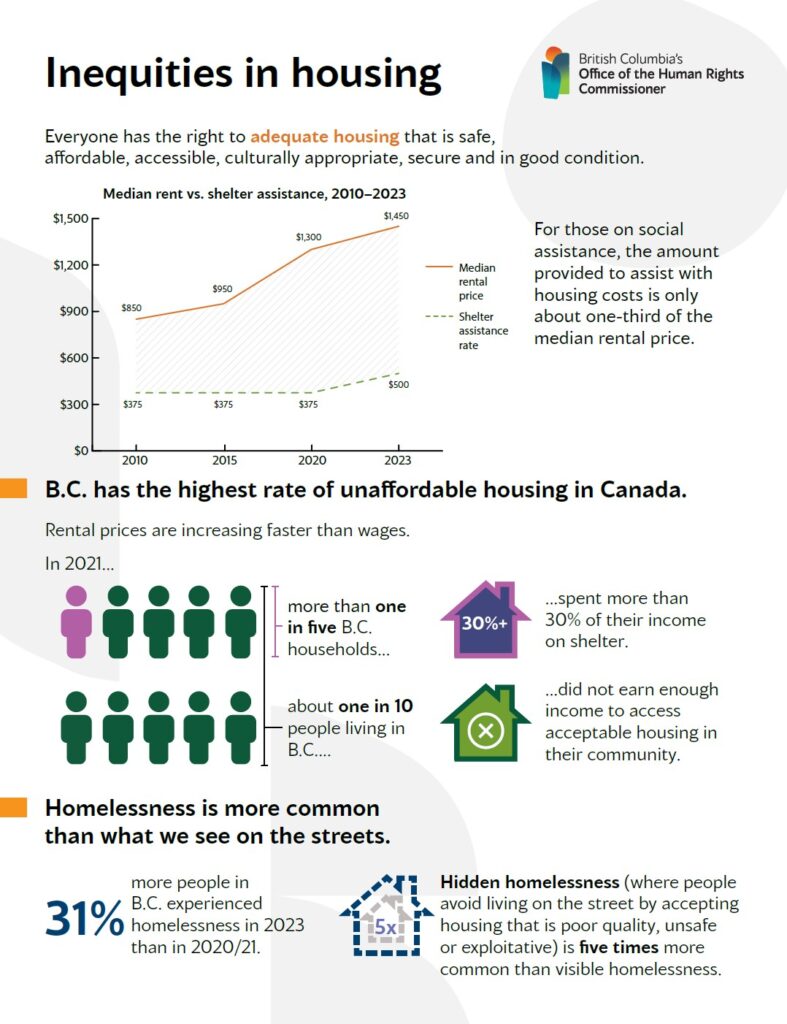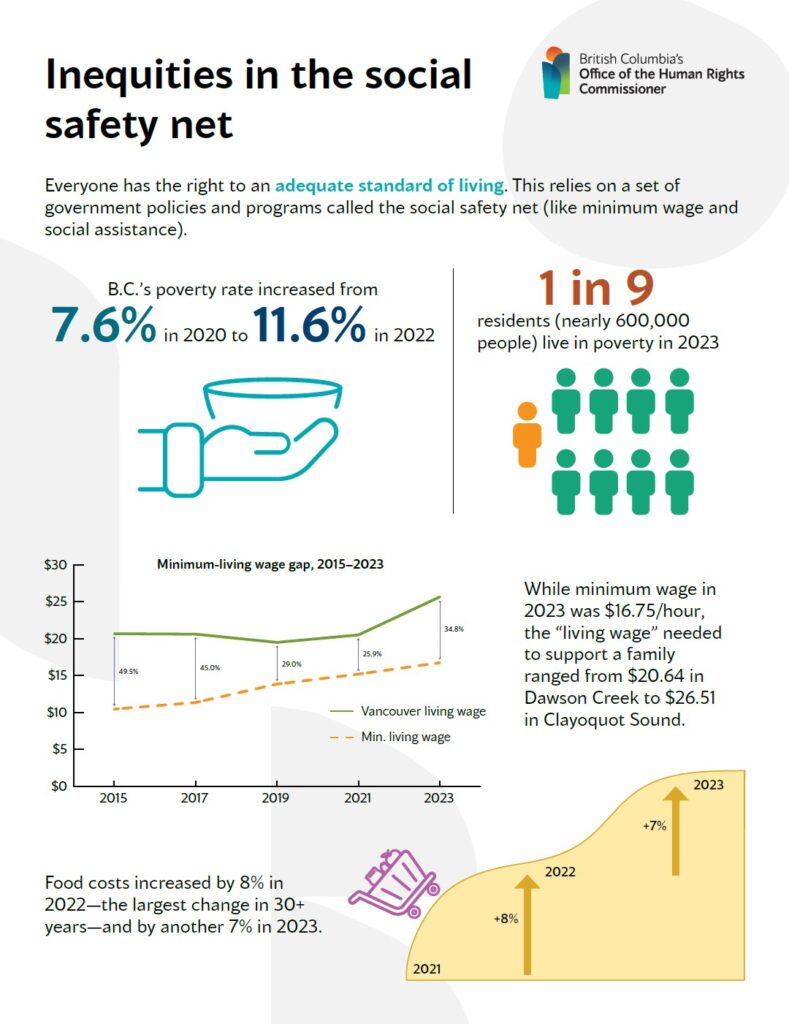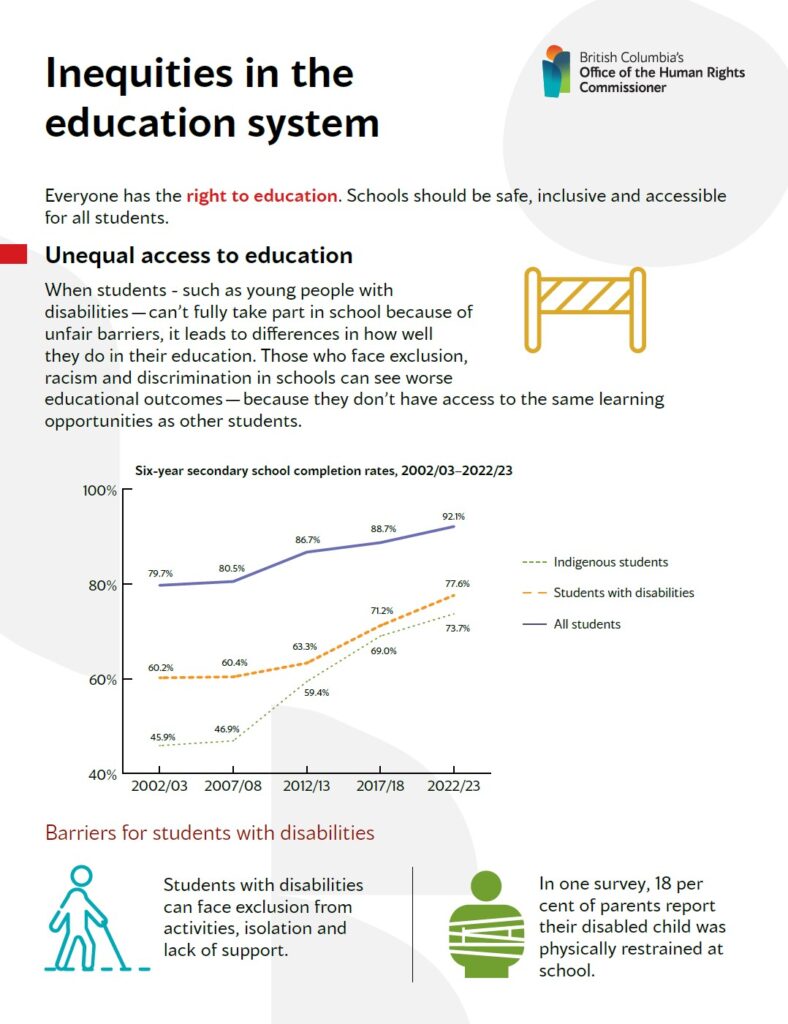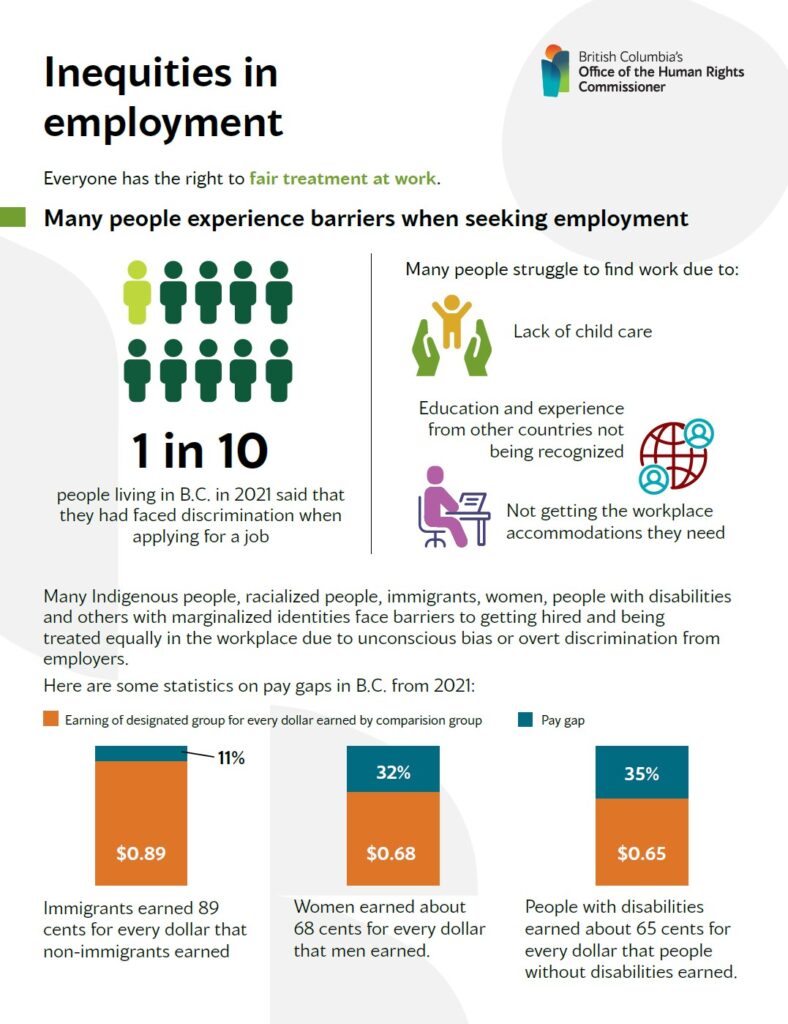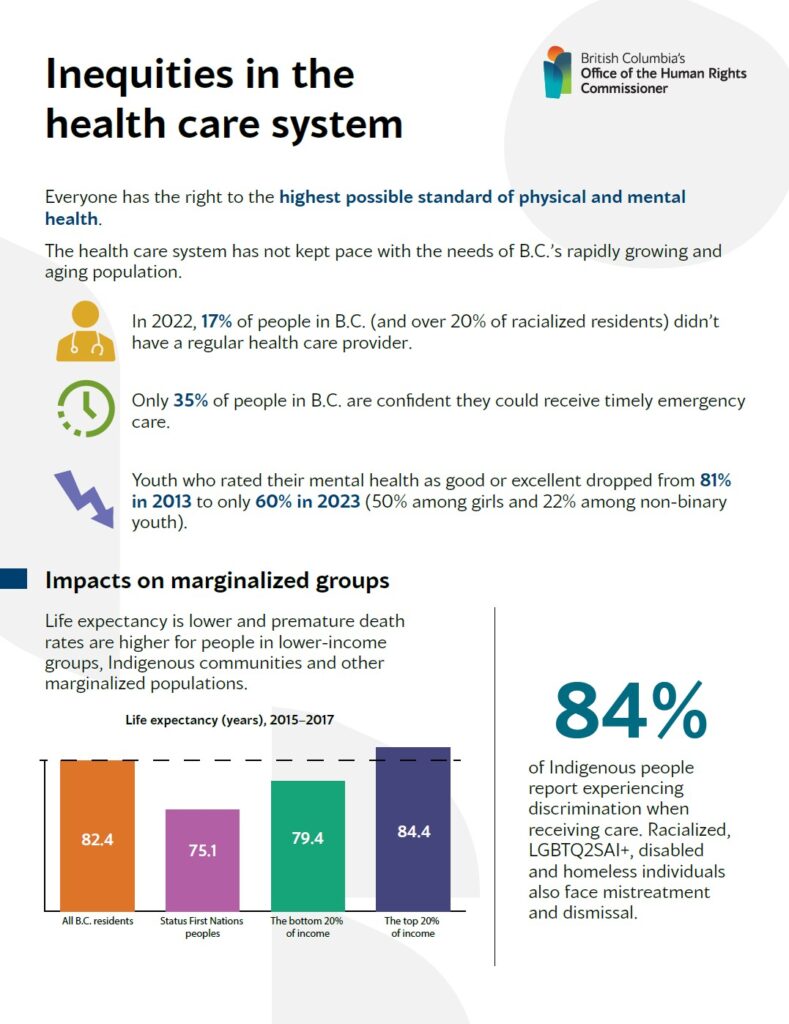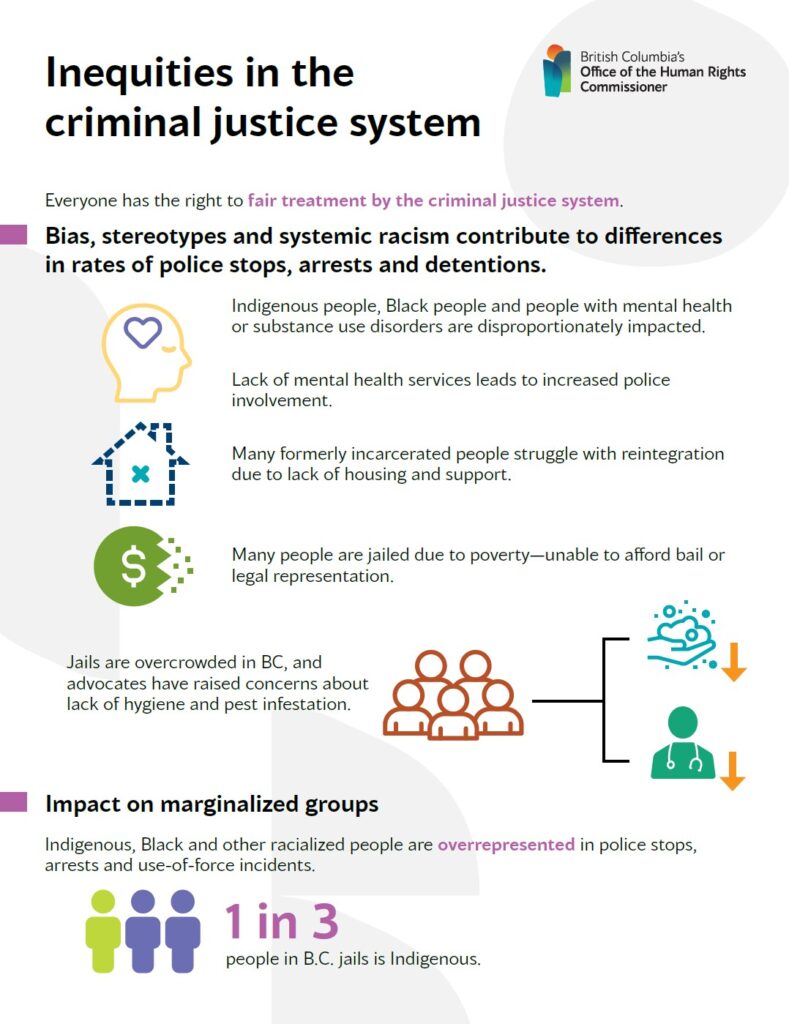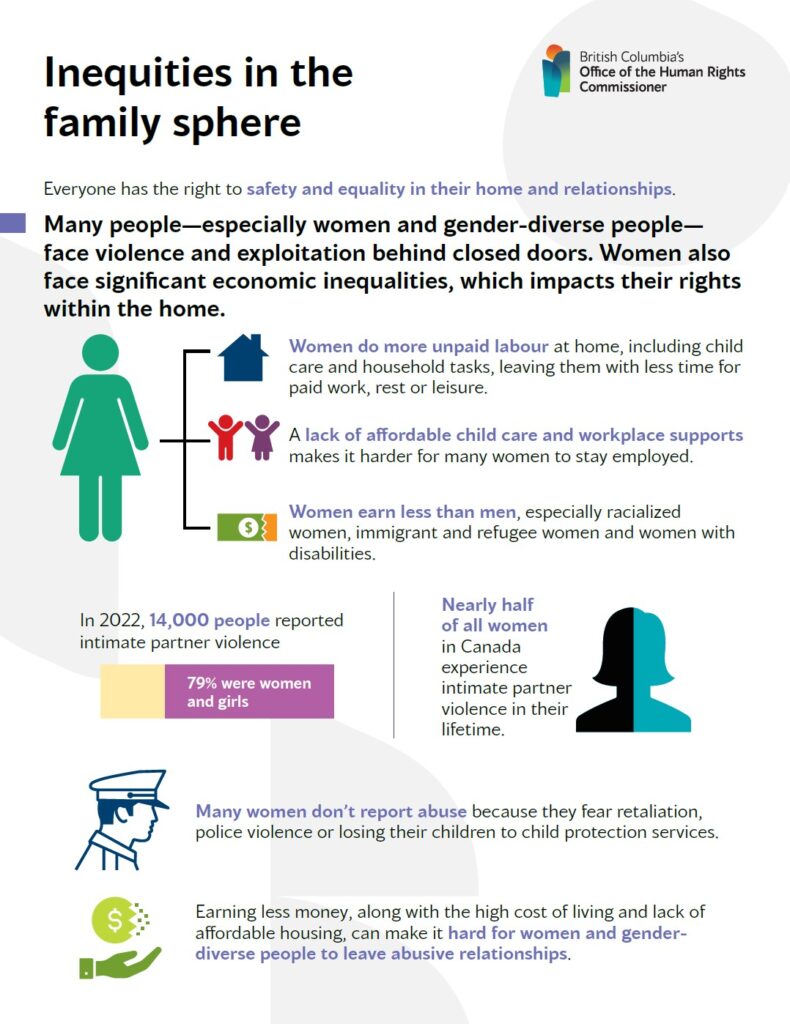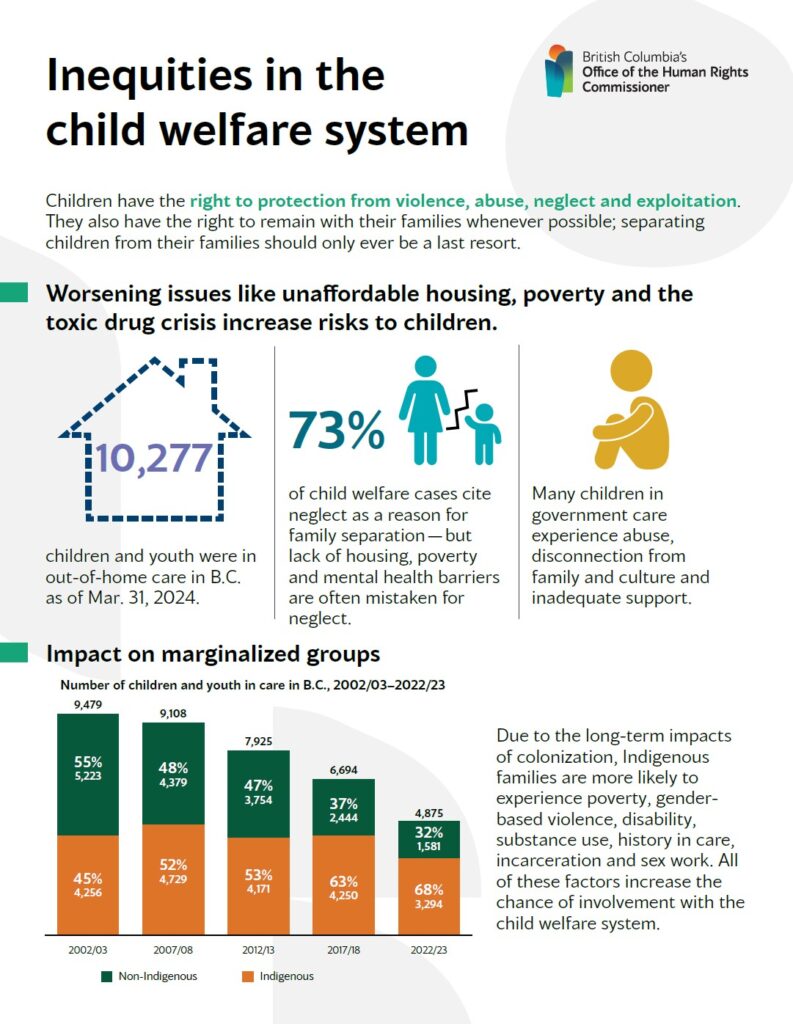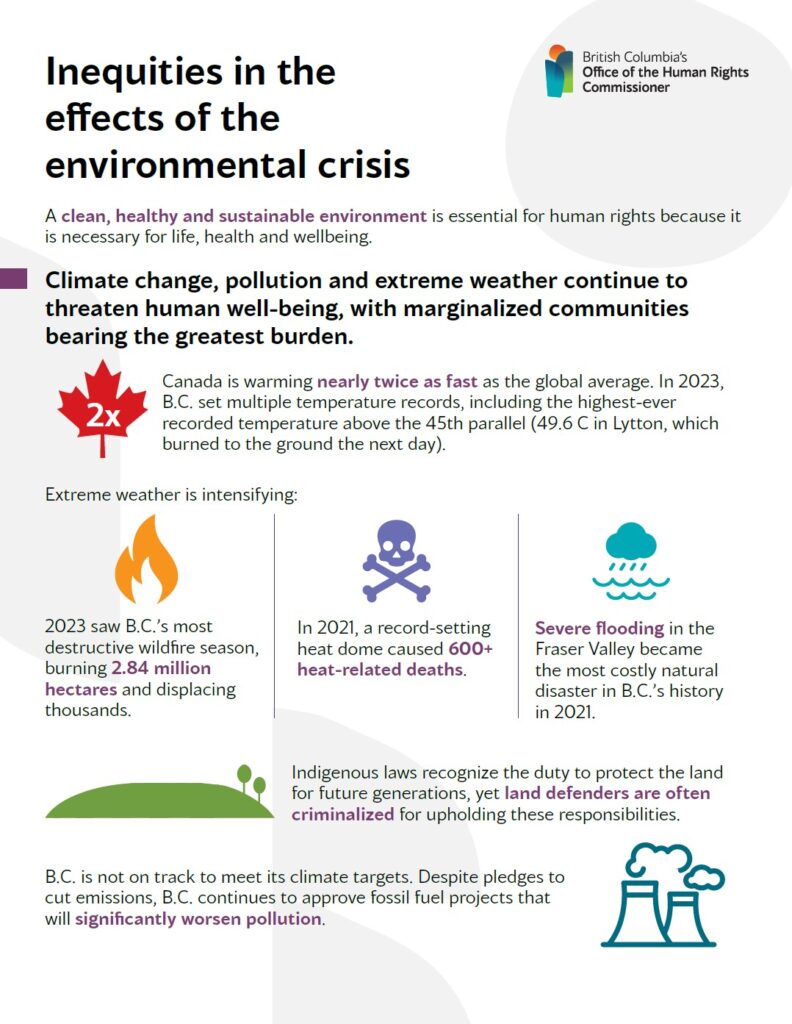

Report
Rights in focus: Lived realities in B.C.
This report highlights significant inequities and injustices affecting B.C. residents, providing a crucial tool to understand the current state of human rights in our province and a kind of baseline to monitor change over time. Download it now or see our executive summary below.
*For desktop viewers, we recommend setting your pdf reader to two-page view.
**If the version available via this page is not accessible for you, please feel welcome to contact our Office to request a printed copy or another format that meets your needs.
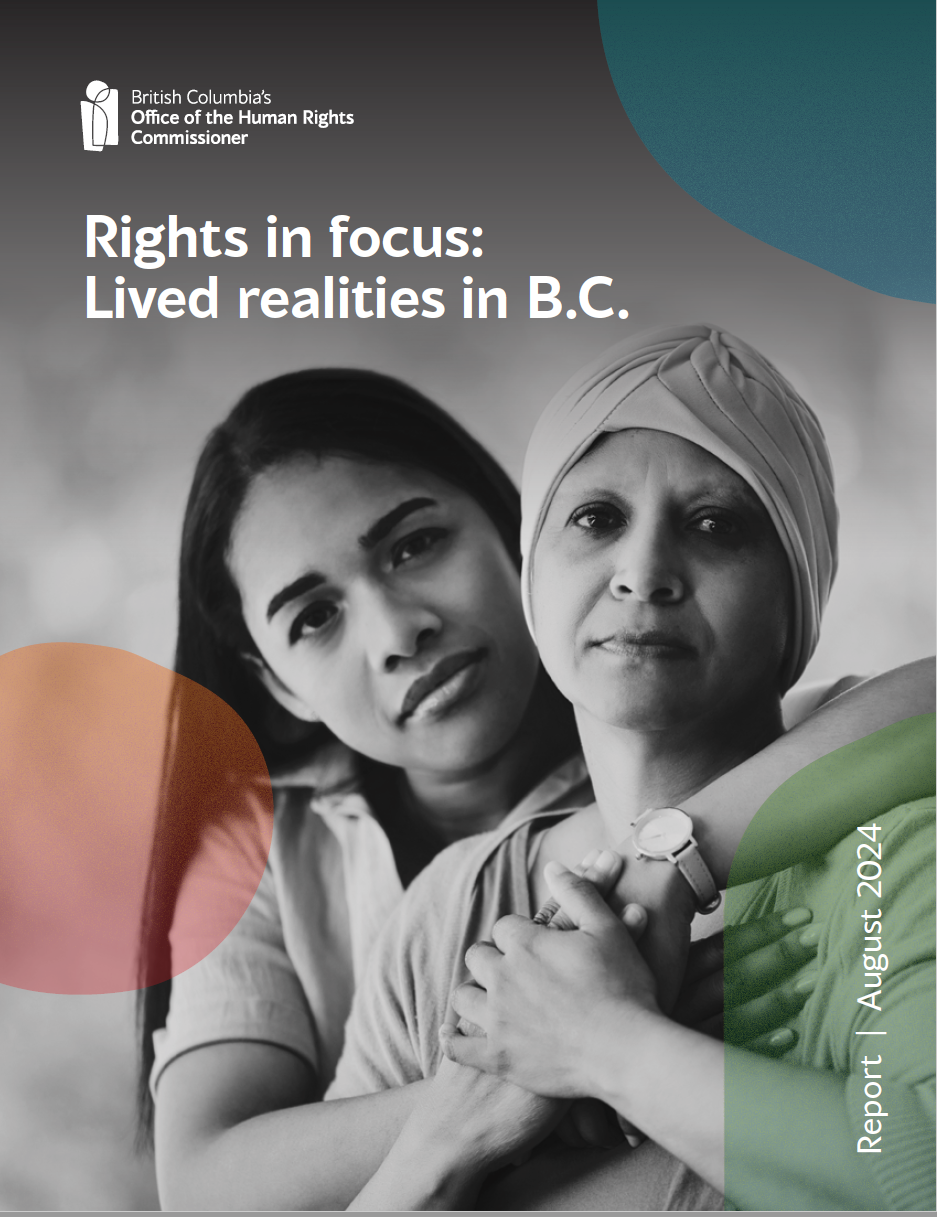
Resources
- Press release: Human Rights Commissioner spotlights 10 key issues impacting B.C. communities in new report
Executive summary
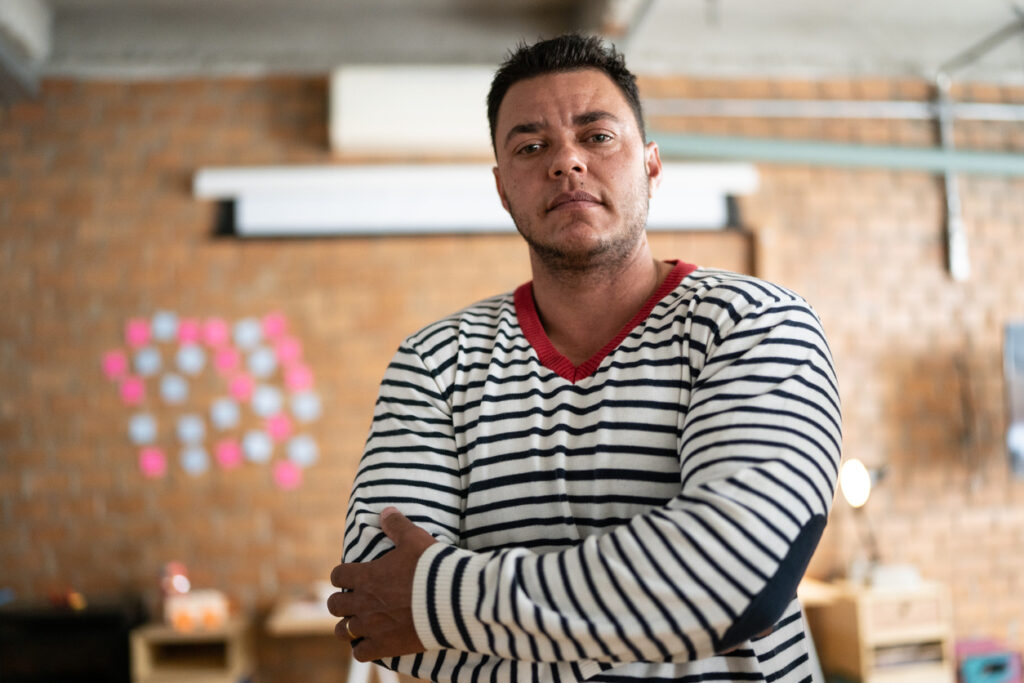
This Rights in Focus report is a snapshot of the state of human rights in British Columbia. The report highlights key inequities and injustices related to ten major issue areas. The report emphasizes how each of these issues raise human rights concerns and the extent to which they impact the most marginalized people in our communities.
Each section in this report focuses on a different system—for example, the child welfare system, the education system and the criminal justice system. We describe how each system impacts particular communities or individuals in disproportionately harmful ways. Each “Spotlight” subsection zooms in on one specific aspect of these broad systemic issues, providing detail on some of the tangible and detrimental ways that issue is impacting people’s lives and human rights.
This report documents what we learned from a variety of sources, including conversations with the people most affected, a survey of organizations working to improve the issues and research produced by academics, governments and non-governmental organizations. It also reflects the legal responsibilities and commitments found in statutory, constitutional and international human rights law, all of which protect the fundamental right to substantive equality.
The 10 issues areas
Housing│Social safety net│Education│Employment│Health│Public spaces│Criminal justice│Family sphere│Child welfare system│Environmental crisis
Inequities in housing
The right to housing entitles everyone to the progressive realization of acceptable housing. Progressive realization means all levels of government are obligated to take steps towards realizing this basic necessity within available resources. Yet B.C. residents face the highest rate of unaffordable housing in Canada. As a result, homelessness and encampments are on the rise: the 2023 homeless count identified 31 per cent more people experiencing homelessness when compared with 2020/21. Lack of affordable housing disproportionately impacts marginalized groups, including people with disabilities, Indigenous people and women. In the housing section, we spotlight how women in particular are more likely to experience “hidden” homelessness, in which they avoid living on the street by accepting substandard, unsafe or exploitative housing.
Beyond the headlines on the housing crisis
Watch this Beyond the Headlines episode for a candid conversation about navigating the housing crisis while keeping human rights in focus.
Inequities in the social safety net
The right to an adequate standard of living entitles everyone to the progressive realization of a life without poverty. This depends on a set of government policies and programs, such as minimum wage and social assistance, called the social safety net. Currently, the social safety net falls short of ensuring an adequate standard of living: about one in nine B.C. residents lives in poverty. Moreover, after years of decline, the poverty rate rose from 7.6 per cent in 2020 to 11.6 per cent in 2022. In the social safety net section, we spotlight how many people experiencing poverty also face discrimination on the basis of their social condition. Unfortunately, such discrimination is not prohibited by law.
Inequities in education
The right to education entitles students to fair treatment in a safe, inclusive and accessible learning environment. In B.C., however, there are large differences between groups in educational outcomes. Evidence shows that groups with worse outcomes face exclusion, racism and discrimination in schools. For example, 92 per cent of all students complete secondary school in six years, but only 78 per cent of students with disabilities and 75 per cent of Indigenous students do the same. In addition, there are gaps in human-rights related education, and teaching social justice content is increasingly controversial. In the education section, we spotlight the experiences of LGBTQ2SAI+ children and youth in schools and controversy around SOGI 1 2 3, a supplementary education resource designed to create inclusive educational spaces. SOGI 1 2 3 has attracted considerable misunderstanding and in 2023 was the subject of large-scale political action.
Beyond the headlines on the housing crisis
Watch this Beyond the Headlines episode for a conversation about how we discuss gender identity and expression with young people.
Inequities in employment
The right to fair treatment in employment entitles people to equality in the workplace. Yet persistent effects of systemic discrimination are evident across the labour market. People with disabilities confront prejudiced views about their work-related abilities. Compared with men, women are more likely to work part-time and earn only 68 cents for every dollar. Indigenous people are less likely than non-Indigenous people to hold secure jobs. One in 10 respondents to a poll conducted for our Office reported experiencing discrimination based on their identity when applying for a job in B.C. This is consistent with other research that shows that people from marginalized identity groups are less likely to be employed, work in secure jobs or hold managerial roles and they earn less for their work. In the employment section, we spotlight the experiences of temporary foreign workers. Workers who come to B.C. temporarily via the Temporary Foreign Workers Program are especially vulnerable, as their immigration status is tied to their employment. This relationship gives employers of temporary foreign workers significant power in the employment relationship and many workers report that power is too often abused.
Beyond the headlines on the housing crisis
Watch this Beyond the Headlines episode to learn how migrant workers are made vulnerable to exploitation.
Discover barriers faced by temporary foreign workers
Watch this short video featuring Dignidad Migrante Society to learn more about issues facing temporary foreign workers.
Inequities in health
The right to health entitles everyone to the highest attainable standard of health. Good health requires timely access to high quality medical interventions, and it also requires things like clean water, nutritious food and adequate housing. In B.C., many people lack access to basic care, including 17 per cent who are without a regular health care provider. People in rural and remote communities face additional gaps in care. People with marginalized identities live shorter lives, report worse mental health and experience discrimination in the health care system. This health care crisis has been worsened in recent years by the COVID-19 pandemic and the toxic drug crisis. In the health section, we spotlight the toxic drug crisis. An unregulated supply of drugs is killing thousands of B.C. residents every year. Yet people seeking treatment face significant barriers, including inadequate staffing, confusing access requirements and insufficient social supports.
Beyond the headlines on the toxic drug crisis
Watch this Beyond the Headlines episode for a conversation about the toxic drug crisis in B.C.
Inequities in public spaces
The right to fair treatment in public spaces entitles everyone to free and full participation in social, political and cultural life. In recent years this right has come under threat from a rise in hate and far-right movements that aim to silence the voices of marginalized people. Hate is common both in outdoor public spaces and online: one in five Canadians, including 29 per cent of racialized people, have experienced some form of hate, harassment or violence online. Hate incidents rose dramatically during the COVID-19 pandemic and again in response to recent violence in Gaza. This rise is reflected in police-reported hate crimes and also in the many incidents not reported to police. In the public spaces section, we spotlight the role of mis/disinformation in spreading hate. As trust in institutions falls, hate is increasingly grounded in mis/disinformation shared online. This was evident in several recent cases, for example, mis/disinformation about the spread of the COVID-19 virus, which contributed to the rise of hate against Asian Canadians.
Inequities in criminal justice
The right to fair treatment in the criminal justice system entitles everyone to equitable treatment by police and correctional institutions. Indigenous and racialized people, as well as people with mental health or substance use (MHSU) disorders, are at severely increased risk of negative interactions with the criminal justice system. For example, on any given day in 2023, about 1,829 individuals were in B.C. correctional centres and over one-third (662) of them identified as Indigenous. In the criminal justice section, we spotlight the experiences of people with MHSU challenges in corrections. For example, many people with MHSU disorders receive treatment in correctional centres, but they are also often subject to traumatizing uses of force such as segregation. In many cases segregation violates international minimum standards for the treatment of prisoners. This creates additional risk for people with MHSU disorders after discharge. For example, rates of fatal overdose more than triple shortly after leaving custody.
Inequities in the family sphere
The right to fair treatment in the family sphere entitles everyone to substantive equality and freedom from violence in their homes and intimate relationships. Inequality within the family sphere continues to be evident in the unequal division of labour; regardless of employment status, women spend more time than men on childcare and household chores. This additional domestic burden is compounded by lower pay in the workforce, together increasing economic vulnerability and making it hard to leave abusive relationships. More than three-quarters of police-reported intimate partner violence (IPV) were women and girls, and IPV is much more common than police-reported numbers suggest. In the family sphere section, we spotlight the misuse of parental alienation allegations in family law cases involving family violence. In some cases, mothers reporting violence face a counteraccusation of “parental alienation”—a claim that they are trying to manipulate children against their father. This claim is often taken seriously by courts but lacks a credible evidentiary basis.
Inequities in the child welfare system
The right to fair treatment by the child welfare system entitles everyone to proactive government action aimed at keeping families safe and together whenever possible.
The number of children and youth in care (CYIC) has decreased in recent years, but the child welfare system disproportionately affects children from marginalized families, particularly those who are Indigenous, experiencing poverty or living with disabilities. For example, despite making up only 10 per cent of the population, 68 per cent of CYIC are Indigenous. Children and youth are often placed in care due to “neglect,” yet many families face systemic barriers that masquerade as neglect but are in fact outside of parental control. Examples include the absence of affordable housing and mental health supports. Children and youth separated from their families for protection also face a new range of risks including physical and sexual violence. In addition, the child welfare system continues to struggle with adequate staffing. In the child welfare section, we spotlight the additional challenges faced by children and youth with disabilities and their families. For children and youth with disabilities, a lack of resources during critical developmental periods can result in health consequences that cascade into inequities throughout their lifetime. Resources are gated behind diagnoses and not all diagnoses are treated equitably. Families are pushed to the limit and some consider placing their children in care in order to access support.
Inequities in the effects of the environmental crisis
All human rights depend on a clean, healthy and sustainable environment. Climate change, extreme weather, pollution and other environmental crises threaten this crucial foundation to human existence. The harm falls disproportionately on marginalized people who have contributed least to the crisis and whose rights are already least secure. This was evident in recent years as unprecedented flooding, heat waves and wildfires destroyed biodiversity, lives and property across the province. Nevertheless, B.C. continues to disproportionately contribute to the climate crisis and is not on track to meet its legislated emissions reduction targets. In the environmental crisis section, we spotlight the important role of Indigenous peoples in addressing climate change. Indigenous peoples remain experts in climate adaptation but their voices have been too often discounted by mainstream initiatives. Centering Indigenous perspectives can revitalize climate adaptation strategies, as has been seen recently in wider recognition of cultural burning and Indigenous fire stewardship.
The systemic inequities highlighted in this Rights in Focus report impact all of us but disproportionately harm those who are most marginalized in our society. The ten issue areas described here are not experienced in isolation; many residents of British Columbia experience violations of their human rights in multiple areas of life in ways that intersect and compound harm.
It is only with understanding that we can act. While this report focuses on where we continue to fall short in upholding the rights of all British Columbians, we also honour the many powerful ways people in all walks of life are resisting oppression, standing up for human rights and disrupting systems to create better ones. Our hope is that this snapshot of human rights in our province will serve as a catalyst for change.

